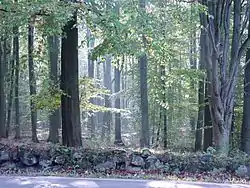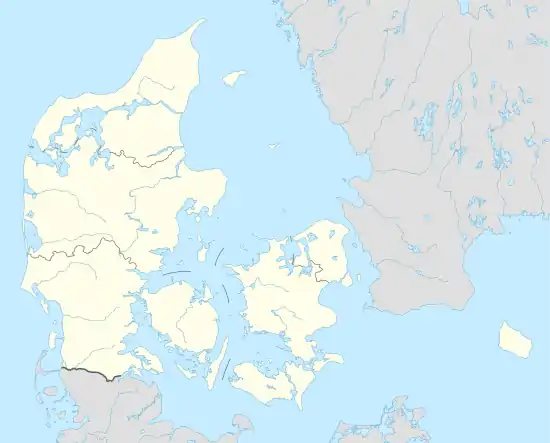Hareskoven
Hareskoven or Hareskovene (plural) is a forested area straddling the boundary between Furesø and Gladsaxe municipalities in the northwestern suburbs of Copenhagen, Denmark. Fægyden, a road between Hareskovby and Værløse, separates Store Hareskov in the west from Lille Hareskov to the west. The forested area has a combined area of c. 808 hectares.
| Hareskoven | |
|---|---|
 Hareskoven viewed from Fægyden | |
| Geography | |
 | |
| Location | Furesø, Gladsaxe, Denmark |
| Coordinates | 55°46′N 12°23′E |
| Area | 8.08 km2 (3.12 sq mi) |
| Ecology | |
| WWF Classification | Baltic mixed forests |
History
The first part of the name (Hare- or Harre-) is derived from the Norse word Hörgr, meaning altar or cult site.
Hareskov was severely damaged during the Swedish Wars in the late 1650s. At the end of the war it was concluded that "the forest will only be able to feed 90 pigs". It was therefore protected for the next few years while it recovered.[1]
Ecology
Harskov consists mainly of beech forest with scattered oak, linden and maple trees. Notable solitaire trees include the three ancient oak trees Skrædderen "The Tailor"), Grenaderen and Djævelen /"The Devil"). The latter used to look like a devil's hand reaching out for the sky. It was partly destroyed in a storm in 1981 but is still alive.
Historic features
Hareskoven contains a total of six dolmens from the Stone Age. The largest one is located close to Sandskredshus at Skovbrynet station.
Two examples of earthworks from the Swedish Wars known as Lejrens Indelukke and Svenskervolden can still be seen in the southern part of the forest.
Activities
Hareskoven forest contains a network of bridle paths for horseback riding as well as a trail for mountain biking.[2]
References
- "Historie" (in Danish). DNaturstyrelsen. Retrieved 24 January 2017.
- "Hareskovene" (in Danish). DNaturstyrelsen. Retrieved 24 January 2017.
